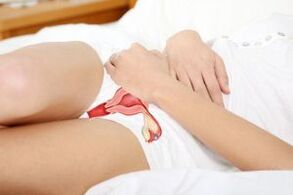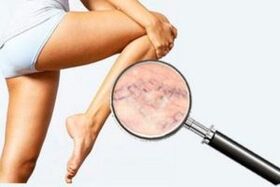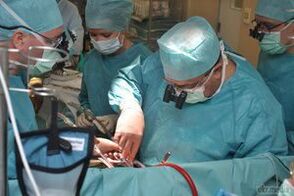Varicose veins of the lower pelvis, unlike similar disorders in the lower extremities, are not always noticeable, but are very harmful to health. May cause deterioration of blood flow to internal organs and dysfunction.
The difference between varicose veins and healthy veins
The wall of a healthy artery is always in good condition - this allows blood flow to be maintained.
The walls shrink, though not as much as in the arteries. This effect is enhanced by the contraction of smooth and skeletal muscles.

All the arteries under the heart, ie. There are valves in the walls of the limbs, abdomen, small pelvis, chest. These are the "pockets" formed by the vascular endothelium.
The blood flowing to the heart is designed to pass unimpeded. In retrograde motion, it fills the valves and closes the vessel.
Blood constantly flows around the heart against gravity.
Varicose veins undergo a number of changes in the valve apparatus. Wall tones decrease and permeability increases. Thus, conditions are created for blood stasis.
Some of the fluid flows around and causes healthy blood vessels to overflow. It also already provokes tone disorders.
What is it and what is dangerous
Varicose veins can affect peripheral blood vessels in any part of the body.
Pathological manifestations of the foot are the most noticeable - it creates a significant aesthetic defect. However, the same phenomenon in the abdomen or small pelvic organs is asymptomatic for a long time.
It is most dangerous for the female reproductive organs, less so for the bladder. Varicose lesions of the rectum manifest themselves with hemorrhoids.
Pelvic varicose veins can have different causes. The disease leads to disruption of blood flow in the reproductive system, resulting in deterioration of its function.
A woman may see changes in her menstrual cycle, pain, and the appearance of signs of hormonal disorders. With physical exposure, vascular rupture and bleeding are possible.
Reasons
multi-factor, ie. arises from a combination of a number of reasons. Among them:
- hereditary tendency;
- lack of physical activity;
- pregnancy complications;
- overweight;
- diseases of the urinary system and intestines;
- heavy physical labor.

The presence of one or more negative factors does not mean dilation of the pelvic vessels. This indicates a high risk of such pathology.
Women with children suffer more than men.
The first symptoms usually appear at the age of 40 or in late pregnancy. The real onset of pathology occurs earlier.
Degrees
There are three stages in the development of varicose veins:
- Mild - damage to one or more peripheral blood vessels of the genitals. It can often be asymptomatic, temporary, and requires re-examination.
- Moderate - dilatation of large vessels of the parametrium - the outer membrane of the uterus or myometrium - the muscle membrane. Causes menstrual disorders, deteriorating health.
- Severe - varicose lesions and edema of most organs of the female reproductive system. Causes serious disorders of the genitals, the risk of disease and infertility.
symptoms
Symptoms vary depending on the location and extent of the lesion. Most of the early stages continue without symptoms.
With the development of the disease, itching, heaviness and pain occur in the external genitalia.
These feelings vary in intensity depending on the stage of the menstrual cycle. Bleeding may intensify and subside after a few days.
A woman may find that her period is more painful and abundant. Sexual intercourse is painful, and there are problems conceiving and conceiving. <
Diagnostic methods
There are several ways to diagnose a disease.
The first and simplest of these is a gynecological examination. Detects dilated blood vessels in the skin, vaginal wall and cervix. His data may indicate an indirect cause - endometriosis, cervical erosion.
The most reliable method is gynecological ultrasound. The advantage is that it allows you to determine the enlargement of the parametrium, fallopian tubes and ovaries. The results of this study provide more detailed information about the state of the reproductive system.
In controversial cases, MRI, vaginal smears, blood tests for sex hormones and diagnostic curettage are prescribed.
Which specialist should you contact for help
Treatment is performed by a gynecologist in conjunction with a vascular surgeon. In case of hormonal disorders, you should consult an endocrinologist. As the disease is multifactorial, other specialists can join the treatment if necessary.
As the disease is multifactorial, other specialists can join the treatment if necessary.
Treatment methods
You should have a reproductive system examination before starting treatment. Identify possible pathologies. As a rule, the disease persists against the background of other diseases.
An integrated approach is used for higher efficiency. Several methods of therapy are used at once, which makes it more successful.
Medication
Includes medications that increase vascular wall tone - Diosmin.
To reduce the permeability of the vessel wall tissue, determine the following:
- ascorbic acid;
- Nicotinic acid;
- Routine.
Even during pregnancy and after birth, it can be accepted if the first symptoms appear in it.
In addition, your doctor may prescribe blood thinners - acetylsalicylic acid, vitamin K.
During pregnancy, when the benefits outweigh the potential harms, it is allowed to use after consulting a midwife-gynecologist.
Compression and Sclerotherapy
Compression tights and belts are worn to prevent varicose vein complications. It puts pressure on the vessels of the external genitalia and prevents them from overflowing.
Therefore, a normal or close to normal venous flow is maintained along the small pelvis. The degree of compression is determined by a physician. You can even wear underwear during pregnancy.
Sclerotherapy is a procedure to inject a specific drug into a vein that stimulates a short-term inflammatory response. And then - complete obstruction and narrowing of the damaged vessel. The blood flow inside stops completely.
This operation can be performed in the 2-3rd trimester of pregnancy, unless otherwise indicated.
Operation
Surgical treatment is the removal of the affected area. It can be done in several ways, depending on the patient's condition.

In some cases, partial resection of the ovary is necessary. Sometimes complete removal of the uterus / fallopian tubes.
In postpartum women, doctors try to protect the reproductive organs.
Physiotherapy exercises
These are exercises that improve blood flow and reduce venous congestion. Most effective:
- "birch tree";
- back bends in the knee-elbow position;
- Exercises to lift the legs and sacrum.
They promote blood flow by gravity.
Folk remedies
Traditional treatment is less effective than hospital therapy, but significantly improves patient well-being.
Medicinal baths are used for this purpose - willow, oak twigs, dried grass and chamomile herbs.
They have a calming effect, reduce tension and stimulate blood flow.
Prevention Tips
It is not possible to completely eliminate all the factors that affect venous flow. But you can reduce the effects. For example, make time for sports, keep your weight at a normal level.
Of particular importance is the prevention of diseases during pregnancy. During this period, it is important to monitor both nutrition and physical activity. And for a sufficient amount of vitamins.
Varicose veins of the small pelvis in women: symptoms and causes, diagnosis and treatment
Pelvic varicose veins are more common in women of reproductive age.
The disease can be easily confused with a number of gynecological diseases, so there is a need for proper diagnosis and appropriate treatment.
Today, varicose veins get sick more often than decades ago. The reason is a sedentary lifestyle.
The disease itself involves a decrease in the elasticity of the venous wall. It can be called differently: varicose veins of the lower pelvis, varicocele, chronic pelvic allergy syndrome. More women of childbearing age suffer from the disease.
Occurrence factors
The most common causes of varicose veins in womenare changes in pregnancy and hormone levels in the body.
The following factors also cause this:
- use of hormonal drugs;
- permanent use of disconnection for contraception;
- sexual disorders: pain and lack of orgasm during close contact;
- multiple and complex births;
- sedentary and sedentary lifestyle or excessive physical activity;
- Congenital connective tissue diseases, weakness of the valves and walls of blood vessels.
The risk of varicocele is increased in women with high concentrations of the hormone estrogen.
In this video about the symptoms and treatment of pelvic varicose veins in women:
symptoms
There are no pathological symptoms when the disease begins in adolescence.
A girl can feel completely normal. And changes in the small pelvis are determined by chance by detailed research methods.
The only symptom in adolescents with varicocele will be severe mucous vaginal discharge that can lead to colpitis.
The most characteristic symptom of varicose veins occurs after a woman reaches reproductive age. It is a pain syndrome that affects more than 95% of patients.
It can bother a woman periodically or at any time, but it is observed throughout life and is pronounced with menopause.
After ovulation, the pain increases in the second stage of the cycle.
Appears in the lower abdomen, is painful or sharp, can affect the spine or sacrum.
Varicose veins of the small pelvis can present with the following symptoms:
- severe premenstrual syndrome;
- Regular vaginal discharge. Whitish, transparent;
- Increased skin sensitivity in the perineum and vaginal mucosa;
- menstrual disorders;
- feeling of pressure and heaviness in the small pelvis, especially if you stay in one position for a long time;
- pain can occur at the end of the day, during sexual intercourse;
- sometimes there are urinary pathologies;
- Pain may occur in late pregnancy;
- pain is noted when examining the lower abdomen;
- On the outer side of the thigh, on the external genitalia, swollen veins may appear on the thigh;
- possible swelling of the vagina and vulva;
- Body weight may increase periodically by 2-4 kg due to fluid discharge into the pelvic region;
- possible apathy, weakness, persistent fatigue, depression.
What causes varicose veins of the small pelvis
Varicose veins are a common pathology of the circulatory system. Residents of economically developed countries are the most susceptible to the disease. In some areas, one-third suffer from this. In this article you will find useful information about varicose veins of the small pelvis: symptoms, treatment and the first manifestations of this varicose vein.
What are pelvic varicose veins? Varicose veins in the small pelvis are caused by poor blood flow. Vessels are full of liquid. Excessive pressure causes the walls of the arteries to become inflamed. The chronic process causes excessive dilation of blood vessels.
Although varicose veins of the small pelvis mainly affect the veins of the genitals, the patient should be monitored by a phlebologist - vascular surgeon, not a gynecologist or urologist.
With varicose veins of the small pelvis, the photo on an enlarged scale clearly shows the excessive elasticity of the vessel walls.
Some people with a disease such as varicose veins of the small pelvis, symptoms and manifestations, can be confused with some diseases of the reproductive system.
Symptoms of small pelvic vessels
Many patients receive adequate treatment before experts recognize pelvic varicose veins. The symptoms of the disease are not specific - can not be used to make an accurate diagnosis:
- Anxiety in the pubis and above is accompanied by painful sensations. The pain is characterized by dullness and cramping, the intensity of manifestation increases with physical exertion, prolonged sitting and standing, excessive warming and excessive cooling. Due to the proximity of venous vessels and the spine, patients complain of discomfort in the lumbar region. Pain is often felt in the perineum.
- Manifestation of varicose veins in the veins of the external genitalia, thighs and upper legs.
- General weakness.
- Depression, apathy, feelings of depression.
Dilated veins of the genitals are unconditional symptoms of varicose veins of the small pelvis. In the photos, the patients have spider veins and nodular protrusions on the skin.
Symptoms in women
Pelvic varicose veins have symptoms typical of women.
- Severity of premenstrual syndrome.
- Dysmenorrhea.
- Sexual intercourse.
- Vaginal discharge.
- Swelling in the external genitalia.
Symptoms in men
The symptoms in men are different from the female manifestations of varicose veins in the small pelvis.
In men, varicose veins of the small pelvis (varicose veins) are often asymptomatic. The only manifestations that are characteristic of this genus may be: periodic cramping pains and a feeling of heaviness in the scrotal area.
Causes
Varicose veins of the small pelvis (varicose veins), the main causes of appearance are quite prosaic, ranging from bad weight lifting habits and sedentary lifestyle. Women of childbearing age suffer more from this disease. With the first manifestations of menopause, the risk of developing this pathology is sharply reduced.
Here are the main causes of varicose veins of the small pelvis:
- Disorders of normal blood circulation in the abdominal organs during pregnancy.
- A sedentary lifestyle to spend a lot of time sitting or standing.
- Weight lifting.
- Impaired blood circulation in the small pelvic vessels due to acute sexual intercourse.
- Use of hormonal contraceptives.
- The negative effect of cigarette smoke on the general condition of blood vessels.
If varicose veins of the small pelvis are detected after a diagnostic examination, it is likely that treatment will cover all measures to alleviate the results, reduce pain and at the same time prevent further development of the disease.
Pelvic Vascular Treatment
Treatment for pelvic varicose veins includes taking medication, doing special exercises, using compression products, and following a prescribed diet. Surgery is performed when conservative therapy methods are ineffective.
When trying to buy compression products, keep in mind that it is not easy to close them without the necessary experience. Don't make it easy for yourself by buying a size larger than you need. The medical form should support the blood vessels and not just touch the skin!
In any case, before making your choice in favor of this or that compression knit product, it is better to first consult with your doctor and find out what manufacturer recommends which model in your situation. You can also find information and reviews on the use of compression stockings from various manufacturers in special medical thematic forums.
Medications
The standard treatment regimen uses the following:
- diosmin - to eliminate the increased elasticity of blood vessels, reduce their permeability, prevent fragility;
- horse chestnut extract (escuzan) - to eliminate swelling and inflammation;
- Vitamin C (ascorbutin) - to strengthen the walls of blood vessels.
Do not treat yourself for varicose veins! This can have serious consequences! If you find appropriate symptoms, contact a specialist.
Pelvic varicose veins and pregnancy
This is the greatest risk of vascular pathology in pregnant women. There are several factors that trigger the disease:
- Increase in circulating blood volume.
- To provide an increasing load on the vessels of the developing fetus. It constricts blood vessels and sometimes completely blocks blood circulation in some areas.
- Increased hormone levels. Some cause a decrease in vascular tone.
- Rapid weight loss during pregnancy.
During pregnancy, pelvic varicose veins cause poor blood supply to the fetus. The growing body will feel a lack of oxygen and nutrients. The consequences of the described disorders can manifest themselves as developmental defects of the child.
Varicose veins of the small pelvis are often the culprit of female and male infertility. It can interfere with successful fertilization, prevent the embryo from adhering to the uterine wall, and disrupt the normal formation of the placenta or reduce sperm production.
Varicose veins of the small pelvis in women: symptoms and causes, diagnosis and treatment
Pelvic varicose veins are more common in women of reproductive age.
The disease can be easily confused with a number of gynecological diseases, so there is a need for proper diagnosis and appropriate treatment.
Today, varicose veins get sick more often than decades ago. The reason is a sedentary lifestyle.
The disease itself involves a decrease in the elasticity of the venous wall. It can be called differently: varicose veins of the lower pelvis, varicocele, chronic pelvic allergy syndrome. More women of childbearing age suffer from the disease.
Occurrence factors
The most common causes of varicose veins in womenare changes in pregnancy and hormone levels in the body.
The following factors also cause this:
- use of hormonal drugs;
- permanent use of disconnection for contraception;
- sexual disorders: pain and lack of orgasm during close contact;
- multiple and complex births;
- sedentary and sedentary lifestyle or excessive physical activity;
- Congenital connective tissue diseases, weakness of the valves and walls of blood vessels.
The risk of varicocele is increased in women with high concentrations of the hormone estrogen.
symptoms
There are no pathological symptoms when the disease begins in adolescence.
A girl can feel completely normal. And changes in the small pelvis are determined by chance by detailed research methods.
The only symptom in adolescents with varicocele will be severe mucous vaginal discharge that can lead to colpitis.
The most characteristic symptom of varicose veins occurs after a woman reaches reproductive age. It is a pain syndrome that affects more than 95% of patients.
It can bother a woman periodically or at any time, but it is observed throughout life and is pronounced with menopause.
After ovulation, the pain increases in the second stage of the cycle.
Appears in the lower abdomen, is painful or sharp, can affect the spine or sacrum.
Varicose veins of the small pelvis can present with the following symptoms:
- severe premenstrual syndrome;
- Regular vaginal discharge. Whitish, transparent;
- Increased skin sensitivity in the perineum and vaginal mucosa;
- menstrual disorders;
- feeling of pressure and heaviness in the small pelvis, especially if you stay in one position for a long time;
- pain can occur at the end of the day, during sexual intercourse;
- sometimes there are urinary pathologies;
- Pain may occur in late pregnancy;
- pain is noted when examining the lower abdomen;
- On the outer side of the thigh, on the external genitalia, swollen veins may appear on the thigh;
- possible swelling of the vagina and vulva;
- Body weight may increase periodically by 2-4 kg due to fluid discharge into the pelvic region;
- possible apathy, weakness, persistent fatigue, depression.













































